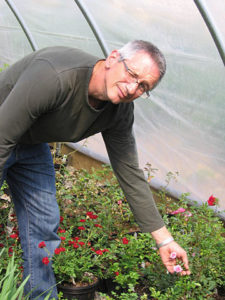 |
| “Der Rosenmeister,” Leon Ginenthal (sitting on his rose bench), owns Der Rosenmeister in Ithaca, New York, a source for hardy roses for local folks and of information on hardy roses for the rest of us. Photo by Sue Smith-Heavenrich. |
by Sue Smith-Heavenrich
While I love roses, I have been intimidated by the idea of actually growing them myself. Oh, I see them blooming in other people’s gardens, rambling along the fences and climbing over the gates. And a number of wild bushes are tucked beneath the trees lining our road. Clearly they thrive on neglect – so why aren’t they in my garden?
That was the question put to me by Leon Ginenthal, known locally as “Der Rosenmeister.” Roses don’t require much more than other plants, he notes. They need sunshine, good air circulation, fertile soil, and maybe, just maybe, to be covered up in the winter. Since I already rake shredded leaves over the herbs, it wouldn’t be that much extra work to rake some over a couple of roses, now, would it?
Ginenthal, who owns a small, specialty nursery, grows roses that are tough enough to survive upstate New York winters. What began with a single cutting from his grandmother’s “Dr. Van Fleet Rambler” grew into a backyard business. When his roses began pushing the vegetables out of the garden, he knew it was time to move to a larger piece of land.
Now situated on 3 acres just outside Ithaca, Ginenthal grows over 200 species of Canadian Explorers, Buck roses, climbers, creepers, floribundas, minis, hybrid teas and heirlooms. There are over 1,000 plants, each with its own story.
“When we finally closed the deal and I could transplant my roses, it was November.” Ginenthal had no time to do much with the clay soil, so he dug the holes, tossed in some compost, planted his bushes and hoped for the best. “They thrived and bloomed, and now are the cornerstone display beds for the business,” he says, challenging me to come up with one good reason these roses won’t grow under similar conditions of soil and benign neglect in my own garden.
 |
| Ginenthal turned his hobby into a business. Roses, he tells his customers, need sunshine, good air circulation, fertile soil, and, possibly, some winter protection. Photo by Sue Smith-Heavenrich. |
Soil, Site and Selection, The Three S’s of Organic Culture
Growing roses organically isn’t difficult at all, Ginenthal admits. You need to consider three major factors: soil, site and selection. The best pH for soil is about 6 – 7, and ideally you want nice, well-drained soil, he notes. Compost is important, and you can’t mix in too much. Some rose growers recommend special composts, such as mushroom compost or Sweet Peet, a mix of composted horse manure and wood shavings. Ginenthal has found that, at least in his potting mix, composted hardwood bark works well, holding water as well as peat does.
Mulch is important too. It covers bare soil, minimizing erosion and cutting down on moisture loss. In addition, mulch absorbs the impact of falling raindrops and prevents fungi and bacteria from splashing onto plants.
Where you plant is important as well. Consider the microclimates around your home as you look for a spot to plant your roses. In one spot pines may block a prevailing wind, while another, lower area may cause colder air to gather in a pocket.
Roses need sunlight, too. As with any other plant, the amount of sunlight affects rose vigor and flower production. More important, sunlight deters fungal growth.
“That’s why pruning is so important,” Ginenthal points out. “Think of it as preventative fungal care.” Fungal diseases aren’t a problem in his gardens, because he allows for good air circulation, both by pruning and with adequate spacing between plants.
“I am also careful in selecting the proper varieties for my gardens,” Ginenthal adds. In addition to being cold hardy, all of his varieties are resistant to black spot and mildew, and in 30 years of growing, he has yet to see rust on his roses.
| Anti-fungal Sprays
Baking Soda Spray Mix and spray on leaf surfaces. You may have to shake the mixture repeatedly to keep it mixed. Some gardeners suggest spraying in the evening, to avoid sunburn. Compost Tea Spray |
Dealing with Diseases
Diseases topping the list for most rose growers are black spot, powdery mildew and crown gall. The first two, caused by fungi, spread under damp conditions. Good cultural practices, including pruning to improve air circulation and providing adequate nutrition and water, go a long way toward protecting roses from fungal diseases. Powdery mildew, for example, tends to show up in stressed plants.
When dealing with black spot, gardeners need to remove infected foliage on and under roses. This means raking up old leaves – but don’t toss infected material into the compost. You’ll need to replace the mulch with a new layer, and this will help keep the fungus from splashing onto new leaves during rains. Shredded leaves, pine needles and grass make good mulches for rose beds.
Some gardeners use companion planting to combat fungal diseases, sowing onions among roses. When nothing else works, many reach for the spray bottle. Fortunately, Cornell researchers have shown that baking soda works well on black spot and powdery mildew. (See the recipe in the sidebar.)
Other fungus-fighting rose gardeners fill their spray bottles with home-brewed compost tea. A good compost tea increases the number of beneficial bacteria in the soil and on plants, and may include protozoa that feed on the bacteria.
Even with an organic fungal spray, the best advice for anyone planting roses is to choose disease-resistant varieties. Modern tea roses and floribundas tend to be susceptible to fungal diseases, but, fortunately for northern gardeners, a good percentage of super-hardy roses are bred from more resistant species. Also look for varieties with glossy leaves, as they tend to be more resistant to powdery mildew than those with matte leaves.
Crown gall is a disease caused by the bacterium Agrobacterium tumefaciens. This soil-borne bacterium enters the plant through a wound in the bark. Infection causes the rose to produce hormones that promote abnormally rapid cell division, resulting in a gall. The most effective treatment for this disease is to remove and destroy the infected plant. You can assume that the soil around plants with crown gall is infected; growing a nonsusceptible crop (such as grass) for three years can essentially eliminate the bacteria from the soil.
A biological control agent, a related bacterium known as Agrobacterium radiobacter, competes with crown gall bacteria in the soil, and some strains produce a toxin that is active against the crown gall bacterium. The biocontrol agent is available commercially as Galltrol or Diegall, and is used as a root dip prior to planting.
| Plants that Attract Beneficials to the Rose Garden
Angelica |
Pest Patrol
Leaf-munching, flower-nibbling Japanese beetles top the list of least-favorite rose garden visitors. Many organic gardeners deal with these invaders the old-fashioned way: beating their bushes with a padded paddle and knocking the beetles into a bucket of soapy water. But gardeners can reduce the attraction of their plants to these pests in other ways, too. Ginenthal attributes his low level of insect damage to not using chemical fertilizers, and to increasing the population of birds and beneficial insects in his gardens.
Chemical fertilizers push roses to grow too quickly, he thinks, and those tender green leaves appeal to hungry beetles. Slower-growing plants, nourished by compost, develop thicker, less tasty leaves. Overall plant health helps decrease insect problems as well.
Mechanical control – picking off insects or using water to wash them off the plants – is another good way to keep pests off roses. Aphids, in particular, can be washed off using a strong spray. Pruning, used to help decrease fungal problems, is a good way to control cane borers. And hand picking, or knocking insects off plants, is a good way to keep beetle populations down.
Many gardeners, including Ginenthal, enlist the aid of natural predators in combating insect pests. By growing a diversity of flowering plants, avoiding chemical sprays, and mulching his beds, Ginenthal creates a welcome habitat for predatory insects, spiders and birds. As Barbara Wilde notes in her book Growing Roses Organically, roses in mixed plantings are less prone to insect attack than those grown in beds devoted to roses.
While some plants attract beneficial insects, others repel Japanese beetles. Interplanting, or companion planting, with white mums, rue, tansy, larkspur and garlic may help deter pests in your beds. Some gardeners use garlic and citronella sprays, as well as Neem.
Gardeners who simply can’t abide the thought of beetle-covered blooms might consider once-blooming roses. Usually their season is over by the time the beetles appear.
Learning More
Leon Ginenthal owns Der Rosenmeister, located in Ithaca, New York. He does not ship his plants, but does have a Web site (www.rosenmeister.com or www.derrosenmeister.com) and a blog, plus his catalog of cold-hardy, disease resistant varieties (a good reference even if you’re too far to buy from him).
Der Rosenmeister’s Favorite Cold Hardy Varieties
Leon Ginenthal grows the following roses in his nursery. He selects varieties that are cold hardy and resistant to black spot and mildew, so if you are looking for some good varieties to start with, you may wish to give these a try.
Canadian Explorer series (hardy to -35 C with only snow as protection), in particular ‘William Baffin.’ Not fragrant, says Ginenthal, but gives maximum bloom.
Griffith Buck Roses (hardy to zone 5 without protection), particularly ‘Applejack’ and ‘Prairie Princess.’ Buck started breeding roses around 1950, using strains of very cold-hardy roses combined with modern hybrid teas and others.
‘Basye’s blueberry’ is a thornless rose with shiny leaves, and resembles a blueberry.
If you are looking for cold hardy, disease-resistant, hip-producing varieties, Ginenthal recommends these:
‘Commander Gillette’ is a thornless species hybrid that can be used as an arching shrub or climber. It makes good hip displays, and seems pretty hardy. Ginenthal rooted a cutting last spring and it survived this past winter.
Most Rugosa hybrids are hardy and produce good hips. ‘Moje Hammarberg’ produces crimson flowers with bright yellow centers and, when ripe, bright red, cherry tomato-sized hips.
‘Purple Pavement’ and ‘White Pavement’ are very hardy, low-growing roses, perfect along the edge of a walkway, or where you need a smaller rose bush. They also produce good hips.
Rosa pomifera, also known as Apple Rose, is a good cottage garden variety and produces abundant hips, but isn’t as hardy as the Rugosas.
Rosa Alba Semi-Plena is an old variety of white-blooming, fragrant rose. These roses are hybrids whose antiquity may go back further than the Roman Empire.
‘Old Apothecary’ rose (Gallica) was used by herbalists throughout the Middle Ages. It produces small round hips and is a compact shrub. Another Gallica variety is Rosa Mundi. These varieties also hold their fragrance when dried, so may be used in potpourri.
References for the Rosarian
Martin, Orin, A Rose Primer: An Organic Approach to Rose Selection and Care, Santa Cruz, Calif.: Friends of the UCSC Farm & Garden, 2005. A 40-page spiral-bound guide available only through the Center for Agroecology and Sustainable Food Systems at UC Santa Cruz. $12. For more information call (831) 459-3240 or visit www.ucsc.edu/casfs.
Olson, Jerry and John Whitman, Growing Roses in Cold Climates, Contemporary Books, 1998.
Osborne, Robert, Hardy Roses, An Organic Guide to Growing Frost- and Disease-Resistant Varieties, Garden Way Publishing, 1991.
Wilde, Barbara, Growing Roses Organically, Rodale Press, 2002.
